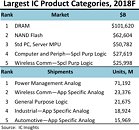Wednesday, August 15th 2018
DRAM Market to Reach $100 Billion Volume This Year
The DRAM market is expected to increase in value some 30% this year, in wake of increased demand and parts shortage due to less-than-adequate production ramp-up to keep up with the demands of modern systems integrators. Doing this, its value will jump to more than $100 Billion in value, marking the first time a semiconductor product category ever surpasses that mark. The 30% increase in value joins an accumulated 78% increase that already occurred in 2017 - a twofold increase in just two years. Who said anything about cryptocurrency having massive increases in value?
IC Insights expects this $100 Billion threshold to be passed this year (a 39% growth), while IBS projects it to only be surpassed by 2019, with a 32% growth for 2018. Still, that's a small differing window which matters little in the grand scheme of things.
Source:
EETimes
IC Insights expects this $100 Billion threshold to be passed this year (a 39% growth), while IBS projects it to only be surpassed by 2019, with a 32% growth for 2018. Still, that's a small differing window which matters little in the grand scheme of things.



14 Comments on DRAM Market to Reach $100 Billion Volume This Year
did you mean price fixing?
The anti-trust bodies of the world should get together to prosecute the trio of price fixers. The consortium should collectively levee a $40 billion fine on them and if they do it again, they will be trust busted (broken apart). The collected fines should fund the creation of a fourth memory manufacturer.
Now it is time for me to study the Stoics. I have wasted to much time as it is on you Epicureans.
Processors are significantly more complex and costly to produce yet DRAM passes it up? Just a paltry 8 GiB of RAM (1 high density stick) will put you in the territory of a budget CPU. The market is rigged. It's not like all of those ARM and x86 manufacturers can just forgo using DRAM. You want one, you're obligated to purchase the other. Because of that relationship (and the fact there's only three now, and the fact they were found guilty of price fixing before) means they'll sell it for whatever they want to and it will be bought.
The interesting part is, for all the people crowing about "self-regulating markets" (where are they on this topic, btw?), according to their logic someone would have increased production significantly by now. Yet that hasn't happened, even if demand is increasing. That definitely speaks to a rigged system. Given that fabs take 2+ years to build and get running, this of course takes time, but this is not a surprising development to anyone. Predicting this growth in demand in 2016 would have been easy - and many did so. It's obvious that there has been cooperation across these "competitors" to not only inflate prices, but also not increase supply before it was absolutely necessary.